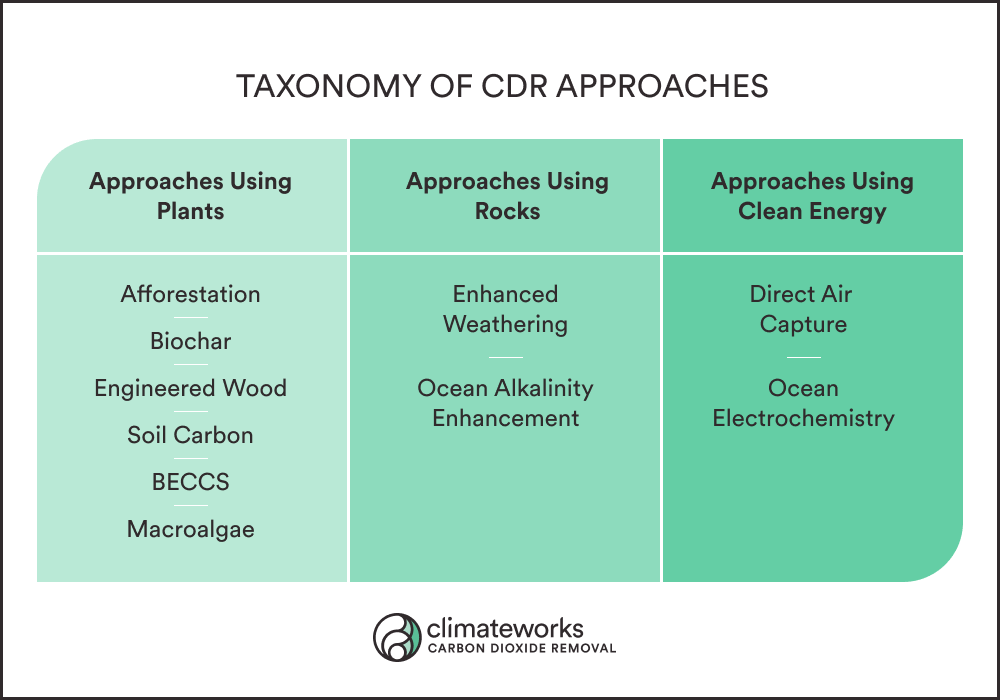
Rapid and sharp reductions in carbon dioxide and other greenhouse gas emissions, such as methane, and the scaled use of carbon dioxide removal are necessary to keep temperatures from exceeding a 1.5° C increase from pre-industrial levels, the goal set by the Paris Climate Agreement. That is the finding from the Sixth Assessment of the Intergovernmental Panel on Climate Change (IPCC), a scientific consensus document that outlines what we know about climate change and what we need to do about it. The Working Group III report, released this week, takes an in-depth look at the pathway towards a safe climate future.
Speeding through our carbon budget has made CO2 removal necessary
Removing excess carbon dioxide is now essential because of continued high rates of global emissions. Since the industrial revolution, carbon dioxide emissions have been building in our atmosphere, creating a warming layer of carbon pollution that is causing climate change. From 1850 to 2019, human activities emitted around 2400 gigatons (Gt) of carbon dioxide, of which around 1000 Gt remain as elevated concentrations of CO2 in the atmosphere, with the rest absorbed by the ocean and land. The IPCC has estimated that, as of 2020, we can only emit around another 500 Gt of CO2 to have a chance of preventing warming from exceeding 1.5° C. This is what is known as our “carbon budget.” Since 2020, we have likely emitted another 80-100 Gt, meaning that we would exhaust the remainder of the carbon budget in less than ten years.
The IPCC has made it clear that keeping the temperature below 1.5° C of warming requires all hands on deck to enact rapid, deep decarbonization. At the same time, a portfolio of responsible carbon removal approaches is needed to prevent or limit temperature overshoot.
Because we have waited too long to reduce our emissions, the carbon budget math shows that even if the world rapidly reduces or eliminates greenhouse gas emissions, we will still need to remove carbon dioxide to have a chance of limiting dangerous levels of global warming. Based on its assessment of the science, the IPCC report states, with high confidence, that “carbon dioxide removal is necessary to achieve net-zero CO2 and GHG emissions both globally and nationally [and] essential to limit warming to 1.5° C.”
Existing pollution is already causing runaway impacts on vulnerable communities and ecosystems
The world is already experiencing average temperatures of 1.1°-1.2° C higher than pre-industrial levels from the greenhouse gas pollution already in the atmosphere. Severe climate-related damages are not something coming only after 1.5° C is reached — they are increasingly being felt today, around the world, and disproportionately impact the most vulnerable communities and those who contributed the least to causing the climate crisis. This is unconscionable and demands appropriate action be taken today.
Furthermore, climate impacts today are straining the natural ability of our ocean and land to take up carbon dioxide safely. Increased CO2 in the ocean causes acidification and harms marine creatures; as trees die from climate-driven drought, pests, and fire, these land ecosystems are less able to absorb CO2. The result is that as our carbon dioxide emissions continue, the build-up of excess CO2 in the atmosphere continues at a faster rate.
Building a diverse portfolio of removal options to increase synergies and minimize trade-offs
The purpose of carbon dioxide removal is to take excess CO2 from the atmosphere and store it away long-term, ultimately helping to restore our climate. Carbon dioxide removal serves three climate purposes according to the IPCC. It helps to keep the world within the carbon budget and stabilizes the climate by reducing the amount of CO2 in the atmosphere in the near term. In the medium term, it helps to zero out emissions from hard-to-abate sectors to help the world reach net-zero emissions. Over the long term, removing more CO2 than we emit may “reverse [global] warming in the latter half of the century,” as stated in the report.
The IPCC report estimates that 5-16 Gt per year of carbon dioxide removal are needed to address emissions that we are not able to fully eliminate by the time we reach net-zero in CO2 emissions, with potentially greater levels of carbon removal needed after that. Ultimately, the amount of carbon removal needed depends on the success of our decarbonization efforts, so this is likely the minimum amount we should be prepared to remove. However, it is a huge increase from the amount we are prepared to remove today.
Fortunately, there is a portfolio of approaches to help restore and leverage the ability of the land and ocean to remove CO2. These removal methods range from restoring forests and soil to growing kelp forests or using carbon-storing rocks to accelerate natural processes that help to buffer the increasingly acidic ocean. All of these removal approaches have synergies and tradeoffs in different contexts (Figure 1).

For example, the IPCC report finds that soil carbon sequestration and planting trees may improve soil quality, biodiversity, and local livelihood, but might negatively impact water, food, and land rights depending on the context of their application. Compared to geological formations’ ability to store carbon over ten thousand years, storing carbon in plants can be reversed due to human or natural disturbances. Yet, more permanent solutions come at a higher cost per ton of CO2 removed today. Researching and developing a diverse portfolio of mitigation and CDR approaches will reduce the need for having to quickly deploy options that may have large trade-offs. Ideally, responsible deployment of carbon removal should seek synergies and co-benefits with other objectives, such as the Sustainable Development Goals.
CDR will not be a one-size-fits-all solution for every country either — the report emphasizes that the combinations of carbon dioxide removal approaches we deploy will need to be context-specific; and the scale and speed of implementation will bring different barriers, challenges, and opportunities for us to address and embrace. All CDR approaches face some form of sociocultural and or legal barriers today. For instance, farmers may not wish to plant trees where they grow crops, communities may not want large fans and synthetic fuel processing centers near their area. As of now, there is limited research on the governance and responsible deployment of carbon dioxide removal. In addition to better understanding carbon removal techniques, we also need to further our understanding of how these approaches interplay with our society. Therefore, the IPCC report recommends accelerated research, development, and demonstration; improved tools for risk assessment and management; targeted incentives and development of agreed methods for measurement, reporting, and verification.
Moving forward responsibly requires all hands on deck
Collectively, the IPCC reports make a compelling case for climate action in general and carbon dioxide removal in particular. Human activities are causing climate change, climate change is already negatively impacting the most vulnerable communities and ecosystems, and those impacts will worsen if we don’t act soon. There is scientific consensus that a combination of deep decarbonization efforts and the scaling up of carbon dioxide removal is necessary to stay below dangerous levels of warming. The world will need a diverse set of stakeholders as well as incentive structures to get to a point where gigatons can be removed responsibly. Doing this will require collaboration, partnership, and meaningful action at all levels.
One thing is certain – we cannot allow abatable fossil fuels to exist alongside our valuable effort in taking legacy emissions out of the atmosphere. To do so would be wasting important resources to perpetuate unsustainable and unjust practices. All stakeholders from government to businesses to local communities must rise to the challenge in developing these nascent but important climate tools guided by inputs from civil society and the science community. Removing legacy carbon emissions should remain a public good and not be co-opted by fossil fuel interests. Ultimately, carbon dioxide removal is too important to get wrong, as it is necessary to keep our climate and planet safe.
As an early mover in supporting the exploration of responsible carbon dioxide removal, ClimateWorks knows that philanthropic action is especially needed to unlock funding for research and development from the public and private sectors. However, annual foundation funding for carbon dioxide removal averaged only $50M from 2016-2020, about 2.6% of total annual climate-related giving by foundations, and mostly went towards nature-based solutions. Philanthropic action thus far has helped to address critical gaps in the physical and social science research around carbon dioxide removal in the early stage of its development. This has enabled public and private sector actors to make more informed and responsible decisions. Going forward, this is a key area for increased and aligned philanthropic funding in the coming decade to create scale-up conditions so carbon dioxide removal can remain a public good and deliver meaningful climate benefits. As with all climate action, philanthropic efforts related to CDR require coordination and partnership to increase the exchange of lessons and learning in this rapidly evolving landscape.
We welcome you to join us in this effort.


